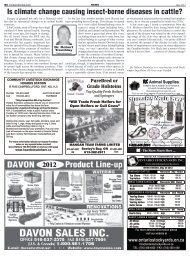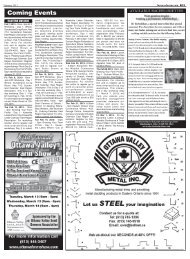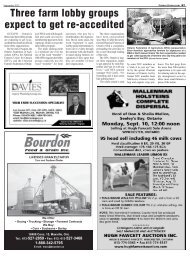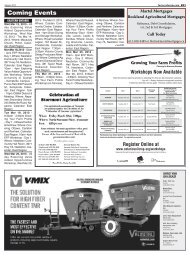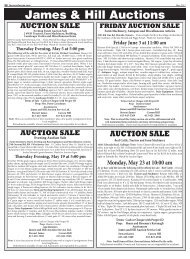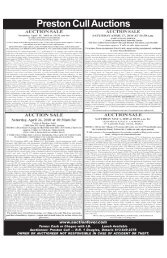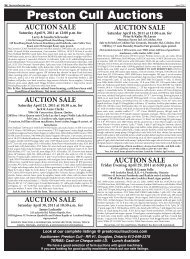Reducing the Risk of Fire on Your Farm - Ontario Ministry of ...
Reducing the Risk of Fire on Your Farm - Ontario Ministry of ...
Reducing the Risk of Fire on Your Farm - Ontario Ministry of ...
- No tags were found...
You also want an ePaper? Increase the reach of your titles
YUMPU automatically turns print PDFs into web optimized ePapers that Google loves.
Introducti<strong>on</strong>Introducti<strong>on</strong>The guide examines <str<strong>on</strong>g>the</str<strong>on</strong>g> major causes <str<strong>on</strong>g>of</str<strong>on</strong>g> farm building fires and what can be d<strong>on</strong>e to reduce <str<strong>on</strong>g>the</str<strong>on</strong>g> associatedrisks. The c<strong>on</strong>cepts <str<strong>on</strong>g>of</str<strong>on</strong>g> fire safety and how <str<strong>on</strong>g>the</str<strong>on</strong>g>y are applied are covered. Strategies are also discussed, using bestmanagement practices, to reduce <str<strong>on</strong>g>the</str<strong>on</strong>g> impact <strong>on</strong> property and business in <str<strong>on</strong>g>the</str<strong>on</strong>g> event that a fire does occur.<str<strong>on</strong>g>Reducing</str<strong>on</strong>g> <str<strong>on</strong>g>the</str<strong>on</strong>g> <str<strong>on</strong>g>Risk</str<strong>on</strong>g> <str<strong>on</strong>g>of</str<strong>on</strong>g> <str<strong>on</strong>g>Fire</str<strong>on</strong>g> <strong>on</strong> <strong>Your</strong> <strong>Farm</strong> was developed for c<strong>on</strong>siderati<strong>on</strong> in relati<strong>on</strong> to farm buildings suchas livestock barns, grain and equipment storage facilities, and o<str<strong>on</strong>g>the</str<strong>on</strong>g>r similar farm buildings <str<strong>on</strong>g>of</str<strong>on</strong>g> low humanoccupancy. The recommendati<strong>on</strong>s pertain to both existing and new c<strong>on</strong>structi<strong>on</strong>, supplementing <str<strong>on</strong>g>the</str<strong>on</strong>g> applicablerequirements <str<strong>on</strong>g>of</str<strong>on</strong>g> <str<strong>on</strong>g>the</str<strong>on</strong>g> Nati<strong>on</strong>al <strong>Farm</strong> Building Code <str<strong>on</strong>g>of</str<strong>on</strong>g> Canada, 1995, (NFBCC) as referenced by <strong>Ontario</strong>’sBuilding Code (<str<strong>on</strong>g>the</str<strong>on</strong>g> Building Code), a regulati<strong>on</strong> made under <str<strong>on</strong>g>the</str<strong>on</strong>g> Building Code Act, 1992. The NFBCC establishesminimum requirements for fire protecti<strong>on</strong> <str<strong>on</strong>g>of</str<strong>on</strong>g> farm buildings <str<strong>on</strong>g>of</str<strong>on</strong>g> low human occupancy.The Building Code Act, 1992 requires that a building permit be obtained before any c<strong>on</strong>structi<strong>on</strong>, renovati<strong>on</strong> orchange <str<strong>on</strong>g>of</str<strong>on</strong>g> use is undertaken. Using this guide does not relieve <str<strong>on</strong>g>the</str<strong>on</strong>g> operator from compliance with <str<strong>on</strong>g>the</str<strong>on</strong>g> prescribedadministrative process or <str<strong>on</strong>g>the</str<strong>on</strong>g> technical requirements in <str<strong>on</strong>g>the</str<strong>on</strong>g> NFBCC. This guide is intended to explain <str<strong>on</strong>g>the</str<strong>on</strong>g>principles and c<strong>on</strong>cepts <str<strong>on</strong>g>of</str<strong>on</strong>g> fire safety, and how <str<strong>on</strong>g>the</str<strong>on</strong>g>y relate to <str<strong>on</strong>g>the</str<strong>on</strong>g> farm and farming practices.There are o<str<strong>on</strong>g>the</str<strong>on</strong>g>r Codes and regulati<strong>on</strong>s to be respected when building, renovating or operating farm buildings.For example, <str<strong>on</strong>g>the</str<strong>on</strong>g> <strong>Ontario</strong> Electrical Safety Code requires that all electrical equipment used in <strong>Ontario</strong> displaya Canadian electrical approval stamp – Canadian Standards Associati<strong>on</strong> (CSA) and Underwriters Laboratory<str<strong>on</strong>g>of</str<strong>on</strong>g> Canada (ULC). If liquid or gaseous petroleum products are used <strong>on</strong> <str<strong>on</strong>g>the</str<strong>on</strong>g> farm, <str<strong>on</strong>g>the</str<strong>on</strong>g>re are Codes specifyingrequirements for <str<strong>on</strong>g>the</str<strong>on</strong>g> safe storage and handling <str<strong>on</strong>g>of</str<strong>on</strong>g> <str<strong>on</strong>g>the</str<strong>on</strong>g>se products. These Codes are enforced by <str<strong>on</strong>g>the</str<strong>on</strong>g> TechnicalStandards and Safety Authority (TSSA). The operator is resp<strong>on</strong>sible for understanding <str<strong>on</strong>g>the</str<strong>on</strong>g>se requirementsas well as o<str<strong>on</strong>g>the</str<strong>on</strong>g>r governing regulati<strong>on</strong>s <strong>on</strong> <str<strong>on</strong>g>the</str<strong>on</strong>g> farm.The guide is intended to highlight best management practices. To fur<str<strong>on</strong>g>the</str<strong>on</strong>g>r reduce risk, <str<strong>on</strong>g>the</str<strong>on</strong>g>re are instances whererequirements greater than those c<strong>on</strong>tained in <str<strong>on</strong>g>the</str<strong>on</strong>g> NFBCC are specified. Do not rely <strong>on</strong> <str<strong>on</strong>g>Reducing</str<strong>on</strong>g> <str<strong>on</strong>g>the</str<strong>on</strong>g> <str<strong>on</strong>g>Risk</str<strong>on</strong>g> <str<strong>on</strong>g>of</str<strong>on</strong>g> <str<strong>on</strong>g>Fire</str<strong>on</strong>g><strong>on</strong> <strong>Your</strong> <strong>Farm</strong> as a substitute for specialized legal or pr<str<strong>on</strong>g>of</str<strong>on</strong>g>essi<strong>on</strong>al advice in c<strong>on</strong>necti<strong>on</strong> with any particular matter.The user is solely resp<strong>on</strong>sible for any use or applicati<strong>on</strong> <str<strong>on</strong>g>of</str<strong>on</strong>g> this guide. Although <str<strong>on</strong>g>the</str<strong>on</strong>g> guide has been carefullywritten, <str<strong>on</strong>g>the</str<strong>on</strong>g> authors, committee and <str<strong>on</strong>g>the</str<strong>on</strong>g> government <str<strong>on</strong>g>of</str<strong>on</strong>g> <strong>Ontario</strong> do not accept any legal resp<strong>on</strong>sibility for <str<strong>on</strong>g>the</str<strong>on</strong>g>c<strong>on</strong>tents <str<strong>on</strong>g>of</str<strong>on</strong>g> <str<strong>on</strong>g>the</str<strong>on</strong>g> guide or for any c<strong>on</strong>sequences, including direct or indirect liability, arising from its use.v



